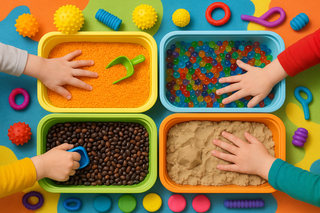Parenting a child with additional sensory needs can be both wonderfully rewarding and occasionally challenging. Everyday activities, which may feel straightforward for many children, can sometimes become overwhelming for a child with sensory sensitivities. As a parent, your goal is to create environments and routines that are not just safe, but also engaging, calming, and supportive.
This post shares practical ideas for incorporating sensory play, calming routines, and supportive tools into everyday life. Along the way, you’ll find links to some helpful items like a stress ball, disco bath lights, sensory bath toys, and fidgets — seamlessly integrated so they feel natural and informative rather than sales-focused.
Why Sensory-Friendly Environments Matter
Children process sensory information differently. Some may be hyper-sensitive to noise or touch, while others seek extra sensory input. A sensory-friendly environment helps children feel safe, supported, and confident.
Sensory play is a key way children learn about their world. It strengthens connections in the brain, aids communication, enhances fine and gross motor skills, and supports emotional regulation. Creating predictable spaces with a variety of sensory experiences allows children to explore safely and enjoyably.
Providing sensory supports is not about “fixing” a child — it’s about offering choice, comfort, and opportunities to engage in play and learning that suits their needs.
Designing a Calm and Engaging Sensory Corner
You don’t need to overhaul your entire home. Starting with a dedicated sensory corner or zone can make a big difference. Here’s how to do it effectively:
1. Set the Scene
-
Use soft, warm lighting rather than harsh overhead lights.
-
Keep the area tidy and uncluttered to reduce visual overload.
-
Include comfortable seating like beanbags, floor cushions, or soft rugs.
-
Use storage baskets or bins so toys can be rotated and easily accessed.
2. Offer Choice and Control
Providing children with options fosters independence and reduces frustration. Examples include:
-
Weighted lap pads or light blankets for proprioceptive input
-
A variety of tactile items such as soft fabrics or small sensory toys
-
A quiet playlist or nature sounds, with a simple way to turn it off
3. Balance Open-Ended and Structured Play
-
Open-ended items allow creativity and tactile exploration, e.g., squishy balls or textured objects
-
Structured activities, like puzzles or stacking games, provide clear goals and focus
4. Rotate Toys Regularly
Too many items at once can feel overwhelming. Rotate 3–5 items weekly, observe which ones the child engages with most, and replace or rest items as needed.
Making Bath Time a Sensory-Friendly Experience
Bath time can be chaotic or calming depending on the setup. With a few simple adjustments, it can become a fun, sensory-rich ritual.
Tips for a Sensory-Friendly Bath
-
Predictable Routine – Use a consistent sequence: warm water, gentle wash, 5 minutes of play, rinse, and wrap up. Predictability reduces stress.
-
Comfortable Temperature – Some children prefer warmer water, others cooler. Test gradually and provide gentle pouring or soft sponges for comforting tactile input.
-
Gentle Lighting – Harsh lights can overwhelm. Consider disco bath lights to create calming, engaging colour changes.
-
Interactive Toys – Floating toys, squirt cups, and soft textures are excellent for sensory play. Explore sensory bath toys to combine tactile and visual stimulation.
-
Soothing Sounds – Gentle water pouring or soft music supports relaxation. Avoid sudden, loud noises.
-
Calm Exit – Use a soft towel and perhaps a favourite toy to transition out of the bath gently.
These simple strategies can turn bath time into an enjoyable, relaxing experience rather than a battle.
Using Fidgets, Stress Tools, and Tactile Supports
Everyday life often presents sensory challenges — waiting in line, travelling in the car, or sitting at a table. Having portable, low-key sensory supports can help.
Types of Tools
| Tool | Benefits | Tips |
|---|---|---|
| Stress balls | Tactile engagement, stress relief | Supervise younger children; avoid toys with hard beads |
| Fidgets | Fine motor practice, focus | Use when needed, not as a reward for behaviour |
| Textured silicone toys | Tactile stimulation | Introduce slowly; observe child’s reactions |
| Weighted lap pads | Proprioceptive input | Use moderate weight (around 5–10% of child’s body weight) |
For example, offering a soft stress ball can provide a tactile outlet during moments of overwhelm, while a selection of fidgets can help a child engage quietly during table activities or car journeys.
Sensory Play Activities You Can Try at Home
Here are some simple, low-prep ideas that provide sensory input and encourage exploration:
-
Textured Treasure Tray – Fill a tray with rice, sand, or beads and hide small objects for the child to discover.
-
Water Transfer Games – Use cups, funnels, and sponges to pour and move water.
-
Balloon Bounce or Tunnel Play – Soft balloons or balls can be tapped, bounced, or rolled to enhance motor coordination.
-
Foam or Shaving Cream Canvas – Spread foam on a tray or table for tactile drawing and play.
-
Colour Mixing Jars – Add food colouring to water in small jars; stir and watch colours blend.
-
Sound Exploration – Use water-filled jars or rice-filled tubes to explore auditory feedback.
-
Movement Break Cards – Simple cards prompting jumping, stretching, or spinning help regulate energy.
Rotate these activities and observe which sensory modalities your child enjoys most — tactile, visual, auditory, or movement.
Integrating Sensory Supports into Daily Life
Consistency helps children feel secure. Consider:
-
Transition support – Offer a tool like a stress ball or fidget before moving between activities.
-
Car journeys – Keep a small bag of tactile items for engagement on the move.
-
Mealtimes – Use textured placemats or short movement breaks.
-
Quiet time – Dim lights, soft music, and tactile play can help wind down.
-
Bedtime routines – Use gentle tactile toys to release energy and support calm sleep.
Observing and Adapting
Not every tool or activity works every time. Observe:
-
Does the tool or activity calm or engage the child?
-
Does it cause overstimulation or frustration?
-
Does interest wane quickly?
Adjust or remove items as needed. A flexible sensory toolkit evolves with your child’s growth, development, and context.
Supporting Parents and Carers
Caring for a child with sensory needs can be demanding. Supporting yourself is essential:
-
Model calm regulation – Using a stress ball yourself during stressful moments can reinforce strategies.
-
Take short breaks – Engage with a fidget or a few deep breaths to centre yourself.
-
Set realistic expectations – Flexibility beats perfection.
-
Seek peer support – Local UK groups or online communities provide practical advice and reassurance.
-
Track patterns – A simple log of activities, reactions, and tools helps identify effective strategies.
Final Thoughts
Creating a sensory-friendly environment at home doesn’t require a complete overhaul — small changes, predictable routines, and a thoughtfully curated toolkit can make a huge difference. Tools like a stress ball, fidgets, disco bath lights, and sensory bath toys can support calm, engagement, and exploration.
Remember: observe, adapt, and rotate. Let your child guide their own sensory journey, while you provide safe, enjoyable, and supportive spaces for them to thrive.



